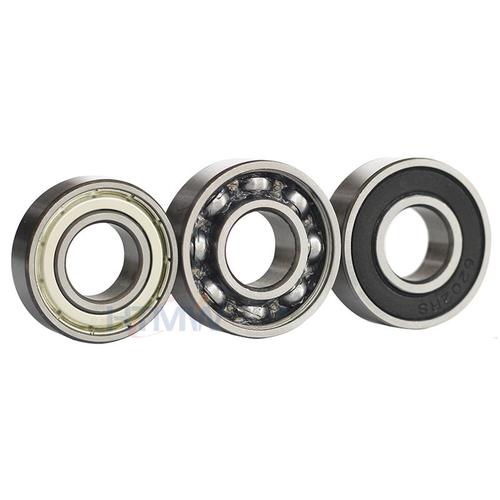Automotive Bearings: Essential Guide to Types, Maintenance, and Top Brands
Automotive bearings are critical components that reduce friction between moving parts in vehicles, ensuring smooth operation and longevity. They are used in wheels, engines, and transmissions, directly impacting safety and performance. Understanding their types, maintenance, and failure signs is vital for optimal vehicle functionality.
1. Types of Automotive Bearings2. How to Replace Car Wheel Bearings
3. Signs of Bad Wheel Bearings
4. Automotive Bearing Maintenance
5. Best Automotive Bearings Brands
1. Types of Automotive Bearings
 Automotive bearings come in various designs tailored to specific applications. Ball bearings are common in wheels due to their ability to handle radial and axial loads. Tapered roller bearings excel in gearboxes and axles, offering high durability under heavy stress. Needle roller bearings, with their slim profile, are ideal for compact spaces like piston pins. Thrust bearings manage axial loads in clutches and steering systems. Each type requires precise lubrication and alignment to prevent premature wear. Selecting the correct bearing ensures optimal load distribution, reduces energy loss, and extends component lifespan. Innovations in materials, such as ceramic hybrids, further enhance heat resistance and performance in extreme conditions.
Automotive bearings come in various designs tailored to specific applications. Ball bearings are common in wheels due to their ability to handle radial and axial loads. Tapered roller bearings excel in gearboxes and axles, offering high durability under heavy stress. Needle roller bearings, with their slim profile, are ideal for compact spaces like piston pins. Thrust bearings manage axial loads in clutches and steering systems. Each type requires precise lubrication and alignment to prevent premature wear. Selecting the correct bearing ensures optimal load distribution, reduces energy loss, and extends component lifespan. Innovations in materials, such as ceramic hybrids, further enhance heat resistance and performance in extreme conditions.
2. How to Replace Car Wheel Bearings
Replacing wheel bearings involves safety precautions and mechanical precision. First, lift the vehicle using a jack stand and remove the wheel. Disassemble the brake caliper and rotor to access the hub assembly. Use a bearing press or slide hammer to extract the old bearing, ensuring no damage to the hub. Clean the mounting surface thoroughly before installing the new bearing. Pack it with high-temperature grease and secure it according to torque specifications. Reassemble components and test-drive the vehicle to check for unusual noises. Improper installation can lead to vibration or failure, so follow manufacturer guidelines strictly. Regular inspections after replacement help detect issues early.
3. Signs of Bad Wheel Bearings
Faulty wheel bearings exhibit distinct symptoms requiring immediate attention. A grinding or humming noise increasing with speed is a primary indicator. Uneven tire wear or steering wheel vibration suggests bearing play. Excessive heat around the wheel hub after driving signals lubrication failure. In severe cases, the wheel may wobble or seize, risking accidents. Diagnose by lifting the vehicle and rotating the wheel manually to feel roughness. Early detection prevents collateral damage to CV joints or ABS sensors. Always replace bearings in pairs to maintain balanced performance. Ignoring these signs escalates repair costs and compromises vehicle safety.
4. Automotive Bearing Maintenance
Proactive maintenance extends bearing life and prevents breakdowns. Regularly inspect seals for cracks to avoid contamination from dirt or moisture. Replenish grease during servicing using products matching OEM specifications. Avoid over-greasing, which causes overheating due to churning. Check for abnormal play by rocking the wheel vertically. Align wheels properly to prevent uneven load distribution. Flush and replace lubricants in differentials or transmissions as scheduled. Store spare bearings in dry environments to prevent corrosion. Ultrasonic testing can detect early-stage wear in industrial applications. Partnering with certified technicians ensures adherence to maintenance protocols and warranty compliance.
5. Best Automotive Bearings Brands
Leading brands like SKF, Timken, and NSK dominate the automotive bearing market. SKF offers premium sealed units with advanced polymer cages for reduced friction. Timken specializes in tapered roller bearings renowned for heavy-duty performance. NTN provides low-noise hubs ideal for electric vehicles. MOOG focuses on aftermarket solutions with easy-install kits. FAG (Schaeffler Group) excels in precision-engineered bearings for luxury cars. When selecting a brand, prioritize OEM certifications, warranty coverage, and compatibility with your vehicle model. Independent lab tests and customer reviews help gauge reliability. Premium brands may cost more upfront but deliver long-term savings through durability.
Understanding automotive bearings is key to vehicle reliability. From identifying wear signs to choosing reputable brands, this guide covers actionable insights. Whether you're tackling a DIY replacement or optimizing maintenance routines, these topics equip you with knowledge to enhance performance. Dive deeper into each section to master bearing selection, troubleshoot issues, and adopt best practices for peak automotive efficiency.
In summary, automotive bearings are indispensable for vehicle safety and efficiency. Regular inspections, timely replacements, and using quality components prevent costly repairs. Stay informed about technological advancements and maintenance strategies to keep your vehicle running smoothly for years.




 13869596835
13869596835